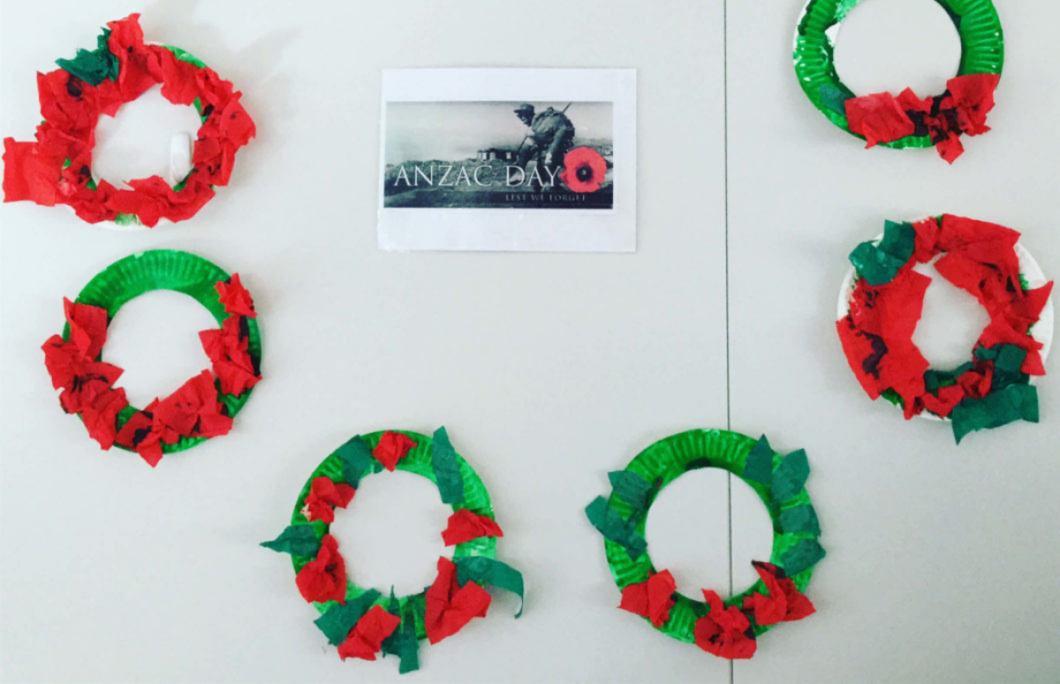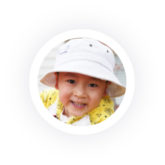Choklits takes pride in acknowledging many significant community events throughout the year. We want our future generations to have a strong understanding of these important events, as well as feel linked to the community they come from.
The foundation of this learning begins early, from our nursery babies all the way through to the kindergarten children. Our knowledge of how early learners best understand and grasp new concepts helps us to build a program that takes into account their levels of development. This includes imagery and symbols, open-ended experiences and lots of invitations to unleash creativity.
This year, the circumstances around self-isolation and COVID-19 mean that we’ve had to be extra creative about experiences, given that we can’t physically connect with the community and lots of our families at home. Some rooms have connected with our house-bound companions via technology, while others have created experiences that can be shared and replicated at home.
In each room, the educators have taken time to plan experiences that reflect each child’s level of development and understanding. You’ll see this reflected in experiences that support a range of abilities, from independent to assisted by a familiar educator. The experiences are set up to be interacted within categories that reflects each child’s stage of development; either completely independently, with minimal educator support or with close educator support. Repeated exposure to the activity over time helps the child move comfortably through the stages at their own pace, while providing a challenge they can rise to meet and learn from.
‘Poppy patty-pan pasting’ in the Nursery
In the nursery room, each child was given the opportunity to complete a pasting. They were provided with a pot of sticky glue, shiny red patty pans to represent poppies, and paper printed with lots of words (“The Ode” from Laurence Binyon’s “For the Fallen”, a remembrance poem).
With the older children seated on a chair at a small table and the younger babies in a high chair, their ability to sit unsupported gave them the opportunity to develop core muscles in their back and abdomen. Their grasping potential was developed by providing them with a chunky brush to hold for the glue, while also supporting their hand-eye coordination and ability to track items visually as they brushed the glue from the pot onto the paper.
The children’s natural curiosity was guided by their interest in exploring the materials provided. Paper to scrunch and sticky glue to feel appeal to our youngest of learners, with their social connections supported by a familiar educator alongside them to guide them and offer instruction and reassurance.
The children’s brain pathways and cognitive abilities were also enhanced by the guidance of familiar educators, providing cues verbally and non-verbally to complete each step. This instruction, as well as the use of their name also built on their language skills. By speaking though each step and adding a visual hint by showing them physically, the children’s ability to imitate actions helped in language development as well as cognition.
Cognition was also extended by exploring the cause and effect nature of the glue; “when I touch the glue it feels sticky, when I connect it to materials, they get stuck”. Experimentation and predictable results are a natural way of learning for these little learners, which we see reflected in the way the play (banging to create sound, throwing toys/balls, all which lead to cause and effect exploration and an understanding of “a+b=c”).
‘Poppy threading’ in the Pre-Toddler Room
In the Pre-Toddler room, the children were given an experience that challenged their fine-motor skills and concentration. A piece of string with one end tightly taped, red cardboard petals, green foil circles and cut-up pieces of black straws formed the materials to create a threaded ‘poppy hanging’.
With this group of children showing more purposeful and controlled movements of their small muscles group (like fingers), they were given a variety of little objects to thread onto the string. Their fine motor skills were challenged as they worked to pick up and hold the small, thin objects. Their hand-eye development was supported by the visual task of coordinating their hand movements to line the hole in each object up with the string, and to push it through successfully.
In this task, their emotional capacity was guided by their own persistence and response to the encouragement of familiar educators. In watching them, some easily picked up the idea of what to do to get the materials on the string, while others benefited from physical help and verbal clues from the educators. All the children showed their ability to keep trying, even when it took a few goes to succeed; the difficulty of trying to get a thin string in a small hole gave lots of opportunity to develop resilience, persistence, and the joy and pride of success.
This age group loves physical exploration, which we could see as they manipulated the materials, turning them over and feeling them with their fingers. The pieces of straws seemed to be the most popular amongst the group, while the more fragile foil pieces seemed the least attractive.
Ability to concentrate on a task showed in the children’s focus and determination during the experiences. Their emotional development was also shown through clapping hands and joyful “Yay!” sounds when pieces were threaded onto the string; the self-evident pride was well-earned and acknowledged by both the children and their educators!
We saw their language development, both expressive through the phrases they repeated after educators and receptive by responding to and following instructions given to them. By copying words and actions of the educators, the children showed that they are cementing familiar vocabulary and learning new words to build on their own understanding.
Through the whole experience, we also saw the children’s bonds with trusted educators, and how they used their relationships to help learn from and respond to the experiences. Their willingness to explore a new activity with the support of trusted adults shows the firm bonds and confidence given through their connections.
‘Poppy-themed playdough and pastings’ in the Toddler Room
The Toddler children show their enthusiasm, curiosity and hunger for learning about the world around them. True to the age, they also show their head-first attitude, strong emotions and desire to be independent (“I do it!” is a well-used phrase among these ‘three-anagers”!).
Educators take into account all these factors in planning captivating and provoking activities for the group. For ANZAC Day, this took the form of poppy pastings and a loose parts playdough activity.
Physically, we know that this group begin to use a more refined ‘pincer-type grip’ to control small objects. Their tiny finger muscles are continuing to prepare to for the skills and technique involved in holding pencils and crayons as they prepare to write in much later years. To support this, educators provided black playdough (courtesy of Nanna Tracey’s renowned playdough kneading techniques) and a range of small poppy-themed items (red buttons, green pipe-cleaners). Provision of open-ended materials allows the children to pace their own learning and create their own visions. A wider understanding and comprehension through conversation allows for discussion about what they’re making and why. This allows for a deeper meaningful conversation about poppy flowers and their link to ANZAC day.
The children were also invited to create a pasting, using tissue paper and paper plates. As well as continuing to support their language through discussions about poppies and verbal instructions, the children’s learning was supported through visual representation of poppy flowers as they constructed their wreaths. Combined with the ANZAC Day loose-parts table (a display of ANZAC symbols, books and other imagery-rich materials) and the playdough experiences, the children’s learning was reinforced in a way that appealed with their age and development.
In creating their pastings, the children were given materials that they were familiar with. This meant that they could engage independently. Exploration with paper plates, red and green tissue paper and glue allowed the children the freedom to create their pasting in any order they chose. Of course, a close educator allowed them to show off their creations and respond to the praise for their wonderful finished products.
We also know that this age group love to ask lots of questions to further their understanding and when they want to seek help. The fast-growing ‘boom’ of words and vocabulary amongst these toddlers shows in their fast-talking and commentary on much of what they do. For that reason, it’s also why an educator is strategically close by to respond to and answer to the comments and questions.
Determination goes hand in hand with these toddlers, so activities like this allow them to persist in an achievable level. That is, they may not succeed the first time with the tricky tissue paper or sticky glue, but by persisting when challenged, they are able to succeed and feel the pride of their achievements, readily shared with educators and peers around them.
‘Poppy wreaths’ in the Pre-Kinder and Kinder Rooms
By the time the children have reached the the space for our oldest learners at Choklits (the Pre-Kinder and Kinder groups), the children show the ability for longer concentration on tasks, and a greater capacity for more difficult tasks. This means more ownership of creating their artwork. Instead of getting their materials ready for them, the children are able to practice their cutting, drawing and precise actions as they create their “Poppy Wreaths”.
They continue developing the muscles used in fine-motor activities, manipulating materials with precise movements like cutting, tearing paper with precision and using a thin brush to apply glue.
Small groups are involved in the activity, allowing for developmentally appropriate turn-taking and sharing of materials. This planning of a small-group activity develops the cooperation needed as the next step in their social learning.
Cognitively, we see the children able to engage with more purposeful experiences, referencing a finished model to create their own replica. A longer attention span and the ability to follow simple instructions helps to guide their learning as they create their wreath.
Language development in this age group allows for more detailed instructions, like, “The red paper goes on top of the green.” While it seems a simple sentence, it requires the child to understand colours, positional language (“on top”) and put it all together in the right order. Reciprocal (back-and-forth) conversations are part of the experience, using each child’s language skills to further their learning.
As with the other age groups, self-pride is one of the major aspects of the experiences. Through each of the steps mentioned, the children are able to create their own individual wreath, all with slight differences, and all proudly displayed.
Choklits is currently adorned with all of the hard-work of the children, with each room decorated with child-made displays. What great experiences that the children have engaged with to learn about ANZAC Day, as well as supporting their learning and development in many other areas. We also love having the children take ownership of their own spaces by displaying their creations to see and identify with pride!
“Lest we Forget” – ANZAC DAY 2020
Resources and references:
- An age appropriate guide to teaching young children about how why and how we can acknowledge the significance of ANZAC day: https://anzacday.org.au/an-introduction-to-anzac-day-for-early-childhood
- Information about developmental levels; a framework for basing our learning experiences on at Choklits (Early Years Learning Framework Practice Based Resources – Developmental Milestones): https://www.acecqa.gov.au/sites/default/files/2018-02/DevelopmentalMilestonesEYLFandNQS.pdf
—
Choklits blog post authored by Dee Wasserfall, Choklits Child Care Kindergarten Educator.
PS- Choklits is a busy place so join the conversation on Facebook and follow us on Instagram for updates from in and around our great Ringwood community!
—
Choklits Child Care, 319 Canterbury Road, Ringwood (opposite the Ringwood Golf Course near the Canterbury Road Eastlink offramp).



